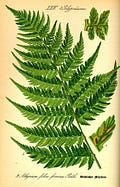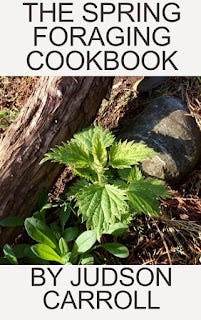The Female Fern, and the Male Fern, that we will discuss next, have long use in herbal medicine. In the Middle Ages, Saint Hildegard von Bingen recommended this herb for those who ail in their intestines, but only for people who are very lean.
Gerard wrote of the Female Fern:
There be divers sorts of Fern, differing as well in form as place of growing; whereof there be two sorts according to the old writers, the male and the female; and these be properly called Fern: the others have their proper names, as shall be declared.
The female Fern hath neither flowers nor seed, but one only stalk, chamfered, something edged, having a pith within of divers colours, the which being cut aslope, there appeareth a certain form of a spread eagle: about this stand very many leaves which are winged, and like to the leaves of the male Fern, but lesser: the root is long and black, and creepeth in the ground, being now and then an inch thick, or somewhat thinner. This is also of a strong smell, as is the male.
The Female Fern is of like operation with the former, as Galen saith. Dioscorides reports, that this bringeth barrenness, especially to women, and that it causeth women to be delivered before their time; he addeth, that the powder hereof finely beaten is laid upon old ulcers, and healeth the galled necks of oxen and other cattle: it is also reported, that the root of Fern cast into an hogshead of wine keepeth it from souring.
Culpepper wrote of both the Female and Male Fern:
Of this there are two kinds principally to be treated of, viz. the male and female. The female groweth higher than the male, but the leaves thereof are lesser and more divided and dented, and of as strong a smell as the male: the virtues of them are both alike, and therefore I shall not trouble you with any description or distinction of them.
Place. They grow both on heaths, and in shady places near the hedge-sides in all counties of this land.
Time. They flower and give their seed at midsummer.
The female fern is that plant which is in Sussex, called brakes, the seed of which some authors hold to be so rare. Such a thing there is I know, and may be easily had upon midsummer eve, and for ought I know, two or three days after it, if not more.
Government and virtues. It is under the dominion of Mercury, both male and female. The roots of both these sorts of fern being bruised and boiled in mead, or honeyed water, and drank, killeth both the broad and long worms in the body, and abateth the swelling and hardness of the spleen. The green leaves eaten, purge the belly and choleric and waterish humours that trouble the stomach. They are dangerous for women with child to meddle with, by reason they cause abortions. The roots bruised and boiled in oil, or hog's grease, make a very profitable ointment to heal wounds or pricks gotten in the flesh. The powder of them used in foul ulcers, drieth up their malignant moisture, and causeth their speedier healing. Fern being burned, the smoke thereof driveth away serpents, gnats, and other noisome creatures, which in fenny countries do, in the night time, trouble and molest people lying in their beds with their faces uncovered; it causeth barrenness.
Mrs. Grieve tells us:
Athyrium Filix-foemina.
The Lady Fern is similar in size and general appearance to the Male Fern. It grows abundantly in Britain, in masses, in moist, sheltered woods, on hedgebanks and in ravines. The rootstock is short and woody; the fronds 2 to 3 feet high, grow in circular tufts and are light, feathery and succulent, generally drooping, and while young and tender, not infrequently soon shrivelling up after being gathered. The leaf base - as already stated - has only two large bundles, and the stalks are less scaly than in the Male Fern. The pinnae are alternate, the lowest decreasing much in size at the bottom, and are divided into numerous long, narrow, deeply-divided and toothed pinnules, with abundant sori on their undersides, the indusium attached along one side, in shape rather like an elongated and rather straightened kidney. The Lady Fern is very variable in form, tint and flexibility: it is more graceful and somewhat more delicate than the Male Fern, and is early cut down by autumn frosts. It is easy of cultivation.
The medicinal uses are as in Male Fern, but it is less powerful in action.
John K’eogh wrote of the Irish tradition:
The root if crushed and taken with ½ ounce of honey and water will expel worms form the body. A decoction of it in wine will dispel obstructions of the liver and spleen. Around midsummer, the country people burn the stalks and leaves of it in order to make ashes with which to whiten their linen clothes.
Plants for A Future states:
A tea of the boiled stems has been used to relieve labour pains. The young unfurled fronds have been eaten to treat internal ailments such as cancer of the womb. The roots are anthelmintic and diuretic. A tea of the boiled roots has been used to treat general body pains, to stop breast pains caused by childbirth and to induce milk flow in caked breasts. The dried powdered root has been applied externally to heal sores. A liquid extract of the root is an effective anthelmintic, though it is less powerful than the male fern, Dryopteris felix-mas.
Young shoots, harvested before they have fully unfolded, can be eaten cooked. They must not be eaten raw - see the notes on toxicity. Used in spring, they are a bitter emergency food. Rhizome - peeled and slow-baked. Reports that the root of this plant were eaten by native North American Indians are likely to be mistaken, it was probably Dryopteris expansa that was used.
The fresh shoots contain thiaminase, an enzyme that robs the body of its vitamin B complex. In small quantities this enzyme will do no harm to people eating an adequate diet that is rich in vitamin B, though large quantities can cause severe health problems. The enzyme is destroyed by heat or thorough drying, so cooking the plant will remove the thiaminase. Although we have found no reports for this species, a number of ferns also contain carcinogens so some caution is advisable.
The Peterson Field Guide to Medicinal Plants tells us:
American Indians used root tea as a diuretic, to stop breast pains due to childbirth, induce milk in caked breasts. Stem tea taken to cause labor. Like many ferns, this was was traditionally taken to eliminate worms. Dried, powdered root used externally for sores. Japanese researches found anti-gout potential in the related fern, A. mersosorum.
The Physician’s Desk Reference for Herbal Medicine states:
Effects: The drug is a mild expectorant; a choleretic-type effect is questionable.
Unproven Uses: The drug is used for respiratory and gastrointestinal tract uses.
Precautions and Adverse Reactions: No health hazards or side effects known in conjunction with proper administrations of designated therapeutic dosages.
This article is an excerpt from
Medicinal Ferns and Fern Allies, an Herbalist's Guide https://southernappalachianherbs.blogspot.com/2022/11/medicinal-ferns-and-fern-allies.html
Available for purchase on Amazon: https://www.amazon.com/dp/B0BMSZSJPS
PS. New today in my Woodcraft shop:
Mother and Toddler set special order (substack.com)
New Book:
The Spring Foraging Cookbook: https://southernappalachianherbs.blogspot.com/2024/01/the-spring-foraging-cookbook.html
Available for purchase on Amazon: https://www.amazon.com/dp/B0CRP63R54
Read about my other new books:
A Daily Catholic Devotional Reflections on the Daily Mass readings July-December, 2024
https://southernappalachianherbs.blogspot.com/2023/12/a-daily-catholic-devotional-reflections.html
Medicinal Weeds and Grasses of the American Southeast, an Herbalist's Guide
https://southernappalachianherbs.blogspot.com/2023/05/medicinal-weeds-and-grasses-of-american.html
Available in paperback on Amazon:
https://www.amazon.com/dp/B0C47LHTTH
and
Confirmation, an Autobiography of Faith
https://southernappalachianherbs.blogspot.com/2023/05/confirmation-autobiography-of-faith.html
Available in paperback on Amazon:
https://www.amazon.com/dp/B0C47Q1JNK
and
Medicinal Shrubs and Woody Vines of The American Southeast An Herbalist's Guide
Read about Medicinal Shrubs and Woody Vines of The American Southeast An Herbalist's Guide: https://southernappalachianherbs.blogspot.com/2022/06/medicinal-shrubs-and-woody-vines-of.html
Available for purchase on Amazon: https://www.amazon.com/dp/B0B2T4Y5L6: by Judson Carroll
Visit my Substack and sign up for my free newsletter:
Read about my new other books:
Medicinal Ferns and Fern Allies, an Herbalist's Guide https://southernappalachianherbs.blogspot.com/2022/11/medicinal-ferns-and-fern-allies.html
Available for purchase on Amazon: https://www.amazon.com/dp/B0BMSZSJPS
The Omnivore’s Guide to Home Cooking for Preppers, Homesteaders, Permaculture People and Everyone Else: https://southernappalachianherbs.blogspot.com/2022/10/the-omnivores-guide-to-home-cooking-for.html
Available for purchase on Amazon: https://www.amazon.com/dp/B0BGKX37Q2
Medicinal Shrubs and Woody Vines of The American Southeast an Herbalist's Guide
https://southernappalachianherbs.blogspot.com/2022/06/medicinal-shrubs-and-woody-vines-of.html
Available for purchase on Amazon https://www.amazon.com/dp/B0B2T4Y5L6
and
Growing Your Survival Herb Garden for Preppers, Homesteaders and Everyone Else
https://southernappalachianherbs.blogspot.com/2022/04/growing-your-survival-herb-garden-for.html
https://www.amazon.com/dp/B09X4LYV9R
The Encyclopedia of Medicinal Bitter Herbs: https://southernappalachianherbs.blogspot.com/2022/03/the-encyclopedia-of-bitter-medicina.html
Available for purchase on Amazon: https://www.amazon.com/dp/B0B5MYJ35R
and
Christian Medicine, History and Practice: https://southernappalachianherbs.blogspot.com/2022/01/christian-herbal-medicine-history-and.html
Available for purchase on Amazon: www.amazon.com/dp/B09P7RNCTB
Herbal Medicine for Preppers, Homesteaders and Permaculture People: https://southernappalachianherbs.blogspot.com/2021/10/herbal-medicine-for-preppers.html
Also available on Amazon: www.amazon.com/dp/B09HMWXL25
Podcast: https://www.spreaker.com/show/southern-appalachian-herbs
Blog:
https://southernappalachianherbs.blogspot.com/
Free Video Lessons: https://rumble.com/c/c-618325
Disclaimer
The information on this site is not intended to diagnose or treat any disease or condition. Nothing on this site has been evaluated or approved by the FDA. I am not a doctor. The US government does not recognize the practice of herbal medicine and their is no governing body regulating herbalists. Therefore, I'm just a guy who studies herbs. I am not offering any advice. I won't even claim that anything I write is accurate or true! I can tell you what herbs have "traditionally been used for." I can tell you my own experience and if I believe an herb helped me. I cannot, nor would I tell you to do the same. If you use any herb I, or anyone else, mentions you are treating yourself. You take full responsibility for your health. Humans are individuals and no two are identical. What works for me may not work for you. You may have an allergy, sensitivity or underlying condition that no one else shares and you don't even know about. Be careful with your health. By continuing to read my blog you agree to be responsible for yourself, do your own research, make your own choices and not to blame me for anything, ever.




